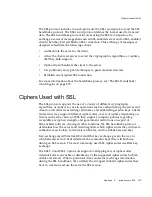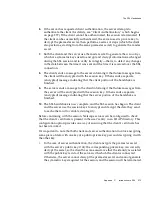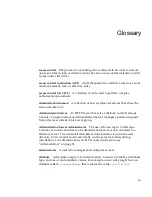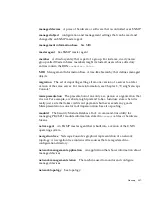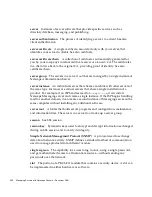
The SSL Handshake
276
Managing Servers with Netscape Console • December 2001
doesn’t correspond to the private key used by the CA to sign the server
certificate, the client won’t authenticate the server’s identity. If the CA’s digital
signature can be validated, the server treats the user’s certificate as a valid
“letter of introduction” from that CA and proceeds. At this point, the client has
determined that the server certificate is valid. It is the client’s responsibility to
take Step 4 before Step 5.
4.
Does the domain name in the server’s certificate match the domain name of
the server itself?
This step confirms that the server is actually located at the
same network address specified by the domain name in the server certificate.
Although step 4 is not technically part of the SSL protocol, it provides the only
protection against a form of security attack known as “man in the middle.”
Clients must perform this step and must refuse to authenticate the server or
establish a connection if the domain names don’t match. If the server’s actual
domain name matches the domain name in the server certificate, the client goes
on to Step 5.
5.
The server is authenticated.
The client proceeds with the SSL handshake. If the
client doesn’t get to step 5 for any reason, the server identified by the certificate
cannot be authenticated, and the user will be warned of the problem and
informed that an encrypted and authenticated connection cannot be
established. If the server requires client authentication, the server performs the
steps described in “Client Authentication,” which begins on page 277.
After the steps described here, the server must successfully use its private key to
decrypt the premaster secret the client sends in Step 4 of “The SSL Handshake,”
which begins on page 272. Otherwise, the SSL session will be terminated. This
provides additional assurance that the identity associated with the public key in
the server’s certificate is in fact the server with which the client is connected.
Man-in-the-Middle Attack
As suggested in Step 4 above, the client application must check the server domain
name specified in the server certificate against the actual domain name of the
server with which the client is attempting to communicate. This step is necessary to
protect against a man-in-the-middle attack, which works as follows.
The “man in the middle” is a rogue program that intercepts all communication
between the client and a server with which the client is attempting to communicate
via SSL. The rogue program intercepts the legitimate keys that are passed back and
forth during the SSL handshake, substitutes its own, and makes it appear to the
client that it is the server, and to the server that it is the client.
Summary of Contents for NETSCAPE CONSOLE 6.0 - MANAGING SERVERS
Page 1: ...Managing Servers with Netscape Console Netscape Console Version6 0 December 2001 ...
Page 18: ...Getting Additional Help 18 Managing Servers with Netscape Console December 2001 ...
Page 20: ...20 Managing Servers with Netscape Console December 2001 ...
Page 40: ...Uninstallation 40 Managing Servers with Netscape Console December 2001 ...
Page 42: ...42 Managing Servers with Netscape Console December 2001 ...
Page 80: ...Working with Netscape Servers 80 Managing Servers with Netscape Console December 2001 ...
Page 110: ...110 Managing Servers with Netscape Console December 2001 ...
Page 118: ...The Netscape Administration Page 118 Managing Servers with Netscape Console December 2001 ...
Page 166: ...166 Managing Servers with Netscape Console December 2001 ...
Page 208: ...Using Client Authentication 208 Managing Servers with Netscape Console December 2001 ...
Page 226: ...Using the Windows NT SNMP Service 226 Managing Servers with Netscape Console December 2001 ...
Page 228: ...228 Managing Servers with Netscape Console December 2001 ...
Page 264: ...Managing Certificates 264 Managing Servers with Netscape Console December 2001 ...
Page 280: ...The SSL Handshake 280 Managing Servers with Netscape Console December 2001 ...
Page 302: ...302 Managing Servers with Netscape Console December 2001 ...






